Sei alla ricerca di un nuovo router wireless? When choosing one of the many models available, you’ll probably notice that you have options with support for many standards: Wi-Fi 7, Wi-Fi 6E, Wi-Fi 6, etc. Which of these standards is better? Il nuovo Wi-Fi 7 ne vale la pena su Wi-Fi 6? Il Wi-Fi 7 fa un buon lavoro di pareti penetranti e offre buone prestazioni? Per trovare la risposta a queste domande, Asus mi ha inviato uno dei suoi più popolari router Wi-Fi 7: The Asus RT-Be92u. Ho usato questo router con Wi-Fi 7 acceso, ho effettuato diverse misurazioni e poi passato a Wi-Fi 6 e le ho ripetute. Here’s what I have found out:
Introducing ASUS RT-BE92U
To evaluate the bandwidth and speed improvements provided by Wi-Fi 7, I used an ASUS RT-BE92U-one of the best Wi-Fi 7 routers I’ve tested so far. It’s an extendable router with many features and tools, including advanced parental controls, VPN, subscription-free antivirus and firewall protection, and more.
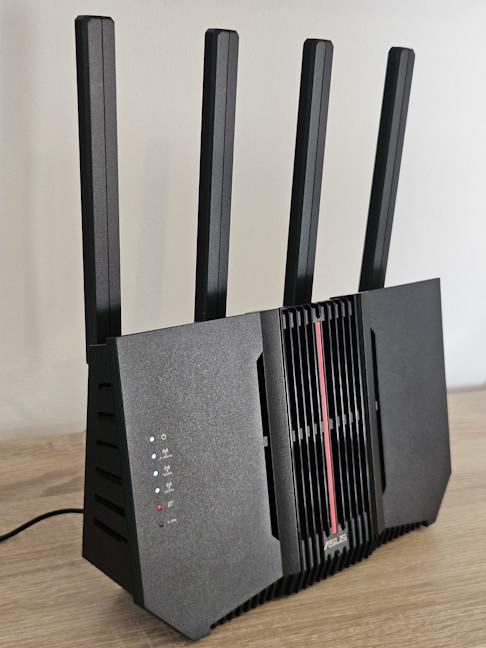

ASUS RT-BE92U-the router I used for my experiment
During my review of this router, I appreciated many things about it, starting with its ability to use 2,5 Gbps e 10 Gbps Internet Connections. La sua performance sulla banda da 2,4 GHz è stata eccellente perché offre trasferimenti wireless utilizzando 3×3 MU-MIMO. It also has four 2.5 Gbps LAN ports so you can connect devices that take full advantage of super-fast internet connections, and it can also be mounted on walls, a feature that many users will appreciate.
Here’s how my apartment is laid out
Below you can see how my apartment is laid out. I’ve placed the ASUS RT-BE92U in a central position to provide good coverage in as large an area as possible.
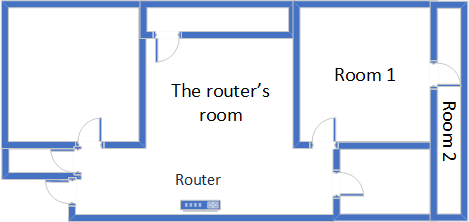

The apartment I which I made my measurements
Before starting the measurements for my comparison, I updated the router’s firmware to the latest version available at the time (v3.0.0.6.102_37506). Then, I took my ASUS Zenbook S 16 laptop and made a few measurements in the following rooms:
Main room-is the room where the router is placed, with no walls interfering with the wireless signal. La stanza 1-è separata da una parete dal router, quindi il segnale wireless e la velocità Wi-Fi che ottengo dovrebbero essere un po’più bassi. Sala 2-è separata dal router da due pareti. Furthermore, the wall between Room 1 and Room 2 is twice as thick as the wall between the Main room and Room 1. As a result, Room 2 can be a difficult challenge for many routers.
Le misurazioni che ho effettuate hanno risultati diversi dalla mia revisione iniziale di questo router, perché la versione del firmware è cambiata. I wanted to compare Wi-Fi 7 and Wi-Fi 6 fairly, using the same firmware version for both standards.
I have an internet connection that offers a maximum download speed of 1 Gbps (typically, around 900 Mbps) and an upload speed that ranges from 600 to 800 Mbps. Ho effettuato diverse misurazioni su tutte e tre le bande wireless: 2,4 GHz, 5 GHz e 6 GHz. First, I enabled Wi-Fi 7 on all three bands and then turned it off, meaning that the router switched to Wi-Fi 6. Keep reading to see my results.
Wi-Fi 7 vs. Wi-Fi 6 on the 2.4 GHz band
I first measured the signal strength on the 2.4 GHz wireless band, using an app named NetSpot. Come puoi vedere nel grafico qui sotto, quando si utilizza lo standard Wi-Fi 7, la potenza del segnale era migliore ovunque nel mio appartamento. Era il 16% migliore nella stanza in cui era posizionato il router e il 10% migliore nella stanza più lontano dal router. Un eccellente punto di partenza. 🙂
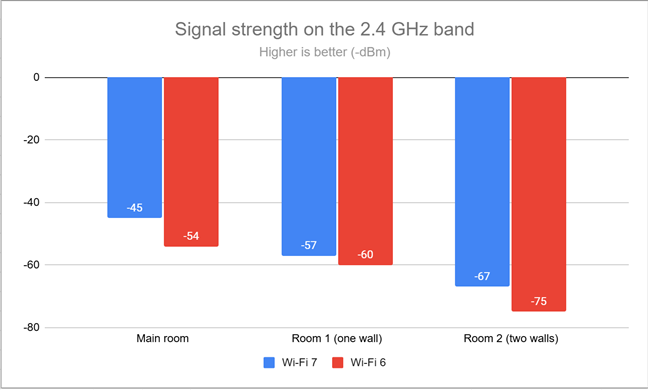

Wi-Fi 7 vs Wi-Fi 6-Signal strength on the 2.4 GHz band
I moved on to SpeedTest, which tells me how fast the internet connection is. Since I’m on the 2.4 GHz wireless band, my experience has shown that I can’t reach the maximum of 900 to 1000 Mbps allowed by my internet connection for the download speed. However, when using the Wi-Fi 7 standard on the ASUS RT-BE92U, I did reach a maximum download speed of 316.92 Mbps in the room where the router was placed. This is a 24% improvement when using Wi-Fi 7 over Wi-Fi 6. The speed improvement was even higher (61%) in Room 2.
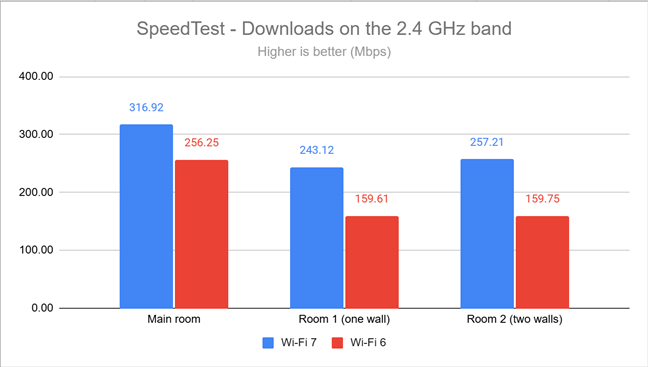

Wi-Fi 7 vs Wi-Fi 6-Downloads in SpeedTest on the 2.4 GHz band
I also measured the upload speed with SpeedTest. The maximum improvement I reached was 185% in Room 1. As you can see below, the Wi-Fi 7 standard delivered much better performance than Wi-Fi 6, in the rooms further away from the router.
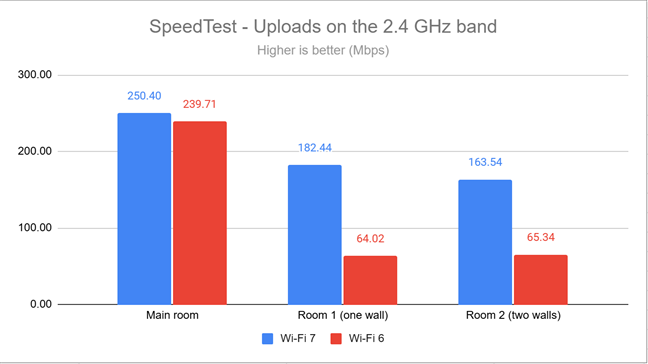

Wi-Fi 7 vs Wi-Fi 6-Uploads in SpeedTest on the 2.4 GHz band
For the last set of measurements on the 2.4 GHz Banda, ho utilizzato il test delle prestazioni del passark per trasferire i dati tra due computer collegati alla rete. One was the laptop I mentioned earlier, connected over Wi-Fi on the 2.4 GHz band, and the other was a desktop computer connected to the router through an Ethernet cable, using a 2.5 Gbps Ethernet connection. Il grafico seguente mostra la velocità che ottieni durante il download di dati all’interno della rete locale. As you can see, when using Wi-Fi 7, I reached download speeds up to 136% higher than when using Wi-Fi 6, in Room 2.
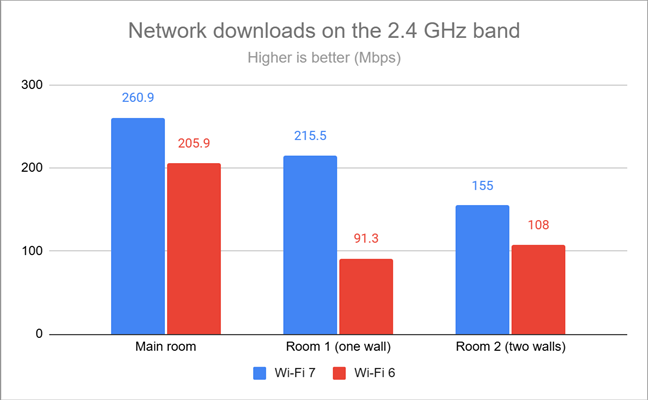

Wi-Fi 7 vs Wi-Fi 6-Wireless downloads on the 2.4 GHz band
The upload speed was always higher when using Wi-Fi 7 over Wi-Fi 6. Per i dettagli, controlla il grafico seguente.
wi-fi 7 vs wi-fi 6-sovraccarichi wireless su The 2.4 GHz Band
Ho passato alla banda a 5 GHz e ho ripetuto le stesse misurazioni, iniziando con la forza del segnale. Questa volta, la situazione era più sfumata. In alcune stanze, Wi-Fi 6 ha fornito una potenza di segnale leggermente migliore (di solito con piccoli miglioramenti), mentre in altri, Wi-Fi 7 ha preso il comando. La posizione in cui il Wi-Fi 7 si è esibito meglio è stata la stanza 2, che è separata dal router da due pareti. muovendosi su SpeedTest a FASTESED a FASTESED a FASTER FISS 7 DELASS 7 DELSTES 7 DELASTS 7 DELASTS 7 DELASS 7 DELSTES 7 DELSTES 7 DELASTS 7 DELSTES 7 DELSTES 7 DELASTS 7 DELSSATS 7 DELSSATS 7 DELSSATS 7 DELASTS 7 DELSSAS 7 Download nelle stanze più lontano dal router. Il massimo miglioramento è stato misurato nella stanza 2, dove Wi-Fi 7 ha offerto velocità di download del 26% più veloci di Wi-Fi 6. wi-fi 7 vs wi-fi 6-scarica in speedtest sulla banda 5 ghz quando misura la velocità Wi-f-fUa Più veloce nelle stanze più vicine al router, mentre Wi-Fi 7 era più veloce in quelle più lontane da esso. wi-fi 7 vs wi-fi 6-caricamenti in speedtest sulla banda 5 ghz il problema con velocità durante questo test. Non riesco a ottenere trasferimenti di dati più veloci della connessione Internet effettiva. Pertanto, mostrare il potenziale di standard moderni come Wi-Fi 7 è difficile. Di conseguenza, non vedevo l’ora di vedere cosa avesse da dire il test delle prestazioni del passark, poiché misura le velocità che ottengo all’interno della rete gestita dall’ASUS RT-BE92U. In questo test, la situazione è cambiata in modo abbastanza drastico, con Wi-Fi che ha fornito entusiasmanti miglioramenti fino al 90% nella stanza 2. I download sono andati oltre 1 Gbps su Wi-Fi, ovunque nel mio appartamento. wi-fi 7 vs wi-fi 6-download wireless sulla banda 5 ghz
wi-fi 7 vs wi-fi di caricamento wivereless sulla banda 5 ghz… Usando la banda a 5 GHz, Wi-Fi 7 offre prestazioni migliorate fino al 90% rispetto a Wi-Fi 6. Tuttavia, per beneficiare veramente da ciò che offre questo standard, è necessario utilizzare una connessione Internet che supera 1 Gbps. Wi-Fi 7 vs. Wi-Fi 6 sulla banda a 5 GHz
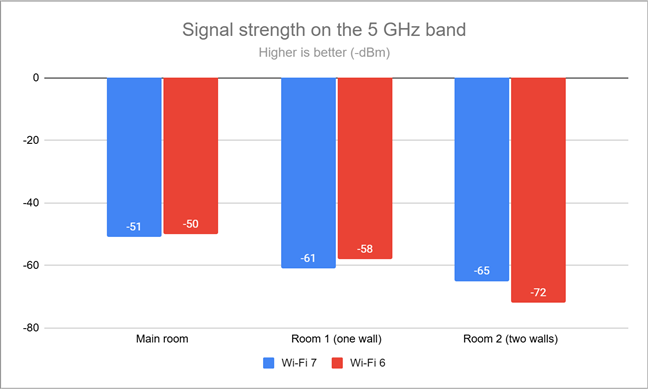
 wi-fi 7 vs wi-fi 6-forza del segnale sulla banda 5 GHZ
wi-fi 7 vs wi-fi 6-forza del segnale sulla banda 5 GHZ 

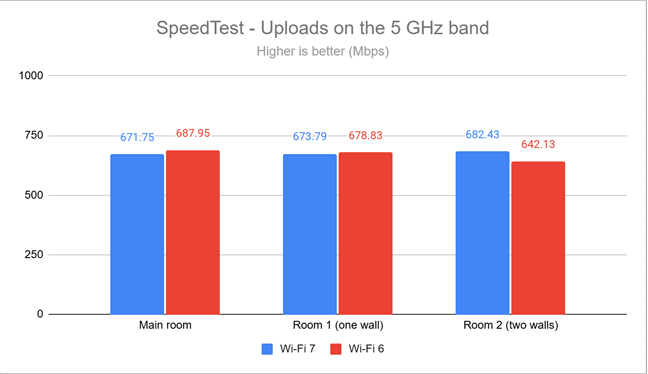

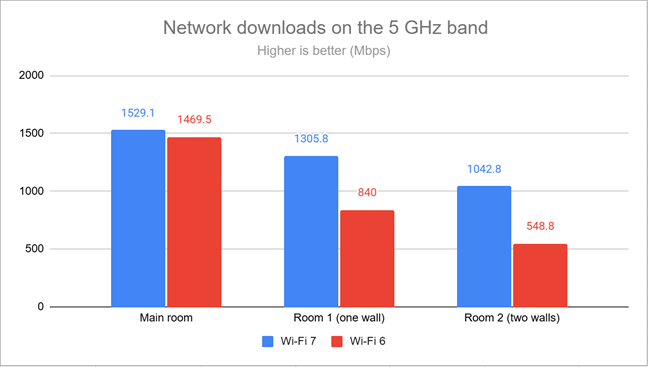

Wi-Fi 7 vs. Wi-Fi 6 sulla banda 6 GHZ
Io-senza WIRASSED a WIRENCEDED: 6 GHI. Quando si misurava la potenza del segnale, Wi-Fi 7 era leggermente migliore in due stanze, mentre il Wi-Fi 6 era migliore in una. Non esiste un vincitore di taglio chiaro a questo proposito, è?
IMG WIGHTH=648″. height=”372″src=”https://www.digitalcitizen.life/wp-content/uploads/2025/03/wifi7_vs_wifi6_asus-14.png”>
wi-fi 7 vs wi-fi 6-uploads in speedtest su 6 ghz banda
quando passano a passerk, passando per le performance, per lo performance, in corsa, per le performance, in corsa, in fase di performance, in fase di corsa, in corsa per le performance, in corsa, in fase di performance, in fase di corsa, in fase di corsa, in fase di corsa, in fase di corsa, in fase di corsa, in corsa, in fase di performance. Wi-Fi 7 ha consegnato download più veloci in due stanze: Room 1 e Room 2. La differenza più alta era del 12% a favore di Wi-Fi 7.
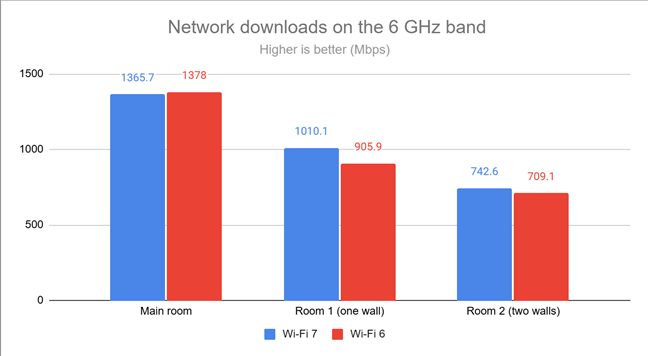
wi-fi 7 vs wi-fi-6-wifri senza carichi wifi su gradati wifi su 6 ghz
La banda wireless a 6 GHz è stata introdotta dallo standard Wi-Fi 6E, che estende Wi-Fi 6. Non troverai alcun router Wi-Fi 6 che offre questa band, solo Wi-Fi 6E. Fortunatamente, lo standard Wi-Fi 7 ha messo a punto la performance di questa band, rendendolo più utile. Nelle mie misurazioni, il guadagno di velocità più grande è stato del 28%.
Come ti piacciono i miei risultati?
Spero che ti sia piaciuto il mio esperimento e hai trovato i miei risultati interessanti. Come puoi vedere, lo standard Wi-Fi 7 può essere significativamente più veloce di Wi-Fi 6, ma non in tutte le situazioni e non sempre. Quando Wi-Fi 6 offre trasferimenti wireless più veloci, le differenze sono generalmente minori. Tuttavia, quando Wi-Fi 7 prende il comando, i miglioramenti possono essere sostanziali a seconda della banda wireless, del dispositivo specifico e della posizione. Prima di chiudere questo articolo, sono curioso dei tuoi pensieri: stai pensando di acquistare un router Wi-Fi 7? I miglioramenti delle prestazioni sono delineati nel mio esperimento abbastanza significativi per te? Si prega di commentare usando le opzioni qui sotto e fammi sapere.
